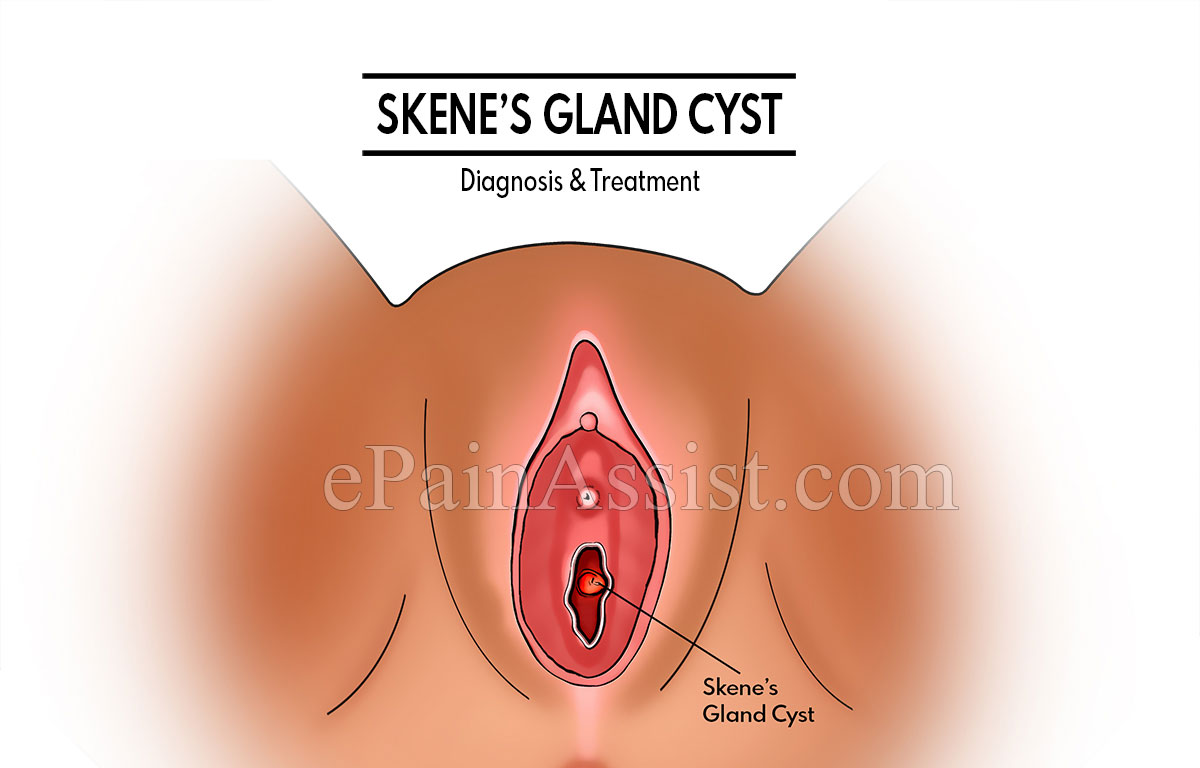Skene’s glands, also known as lesser vestibular glands are located on either side of the urethra in women. While the exact role of the gland is not fully understood, it is believed to be related to female ejaculation during sexual arousal. In some rare cases, a skene’s gland cyst may be noted, possibly due to blockage of the glands.
Skene’s glands are also known as paraurethral glands and are bilateral prostatic homologues glands. It was first discovered and described by Alexander Johnston Chalmers Skene in 1880. The obstruction of Skene’s ducts due to infection, inflammation due to skenitis due to gonorrhea or cystic degeneration of embryonic remnants of the paraurethral glands can cause paraurethral cysts. This condition is called Skene’s gland cyst, which is often rare.1
Skene’s glands are periurethral or paraurethral glands located adjacent to the distal urethra. The tissues surrounding them are a part of the clitoris. These glands secrete a substance to lubricate the urethra opening. The substance is thought to be anti-microbial and can prevent urinary tract infections. Although the exact role of these glands is not clear, it is believed to be related to female ejaculation during sexual arousal.2
What is Skene’s Gland Cyst?
Skene’s gland cyst is considered rare, however, some cases have been reported affecting various age groups. Skene’s duct cyst develops near the distal urethra and can cause perineal discharge, dyspareunia, or abscess formation in some cases.
Most people with Skene’s gland cyst may not have any symptoms or some experience minor irritation during urination or sexual activity.
It is believed that Skene’s gland cyst is retention cysts that result from secondary to inflammatory obstruction of the Skene’s ducts in females.3 Most Skene duct cysts are less than 1 cm and usually do not cause any symptoms, while some larger ones can cause complaints and eve cause dyspareunia.
Skene’s gland cyst form when the duct gets obstructed either due to infection or inflammation. It can get infected resulting in urinary tract infections and abscesses. Some large Skene’s gland cyst or cysts in the duct can even obstruct the urethra and restrict the flow of urine. This can cause difficulty in passing urine and can also cause pain in the urethra. The symptoms noted in such cases include hesitant start at the beginning of urination, dribbling at the end of urination, and retention of urine. Large cysts can cause pain during urination and even during sexual intercourse.
In very rare cases, abscesses may be formed due to the cyst, which can be tender, very painful, and get swollen. The skin over the area may appear red. Fever is usually not to be present. It is either treated with antibiotics or may have to be removed surgically.4

How are Skene’s Gland Cysts Diagnosed and Treated?
Skene’s gland cyst is usually diagnosed on clinical examination. It is usually done when the cyst is symptomatic and medical help is sought. In most cases, the symptomatic cysts are palpable and can be diagnosed clinically. Sometimes, asymptomatic cysts may also be noted during pelvic examination for other purposes. During a pelvic examination, the doctors may feel the gland cyst or abscess, if they are large.
However, in some cases, for better viewing or confirmatory diagnosis additional tests may be done. Usually, ultrasonography or cystoscopy (using a flexible tube to view the bladder) may be done to confirm the diagnosis. In some cases, if needed, additional scans like MRI may be done. It may appear as round or oval masses located laterally to the external urethral meatus and inferior to the pubic symphysis.3
Other conditions that must be considered before making a diagnosis include the Bartholin gland cyst and urethral diverticulum or urethrocele.
Treatment of Skene’s gland cyst mainly depends on the presence and severity of the symptoms and the size of the cyst.
- Generally, the commonest treatments involve removal of the cyst, also called surgical excision or marsupialization if the cyst is symptomatic. In marsupialization, a small cut is made into the cyst and the edges of it are stitched to surface of the vulva, thus allowing the cyst to drain.
- The cyst that has resulted in abscesses are treated with antibiotics initially. They are then excised and drained.
What Do Some Case Reports Of Skene’s Gland Cyst Say?
While it may be noted in adults, cases have been reported when females of varying ages have suffered from Skene’s gland cyst. A study report about a case of Skene’s gland cyst in a 1-day-old female infant states that it is a rare congenital anomaly in female newborns babies. Although physical examination alone can help diagnose the condition, knowing about the condition can help plan only necessary investigations and interventions.5
Skene’s glands secrete a mucoid material with sexual stimulation. However, in newborns, the paraurethral glands may sometimes respond to maternal estrogen and secrete the mucoid substance. The condition is rare, especially in newborns and the exact cause is not known. But possibly conditions like an infection, inflammation, or cystic degeneration of embryonic remnants of the paraurethral glands can lead to the obstruction of Skene’s ducts.
In neonates, the condition may present as an asymptomatic bulging mass with small vessels on the surface, located on either side of the urethral meatus. Skene’s gland cyst may have no manifestation, but a careful study of the urinary tract is necessary to exclude complications or different severe injuries.6
Here is about another case of Skene’s glands cyst in a 37-year-old woman. She presented with a complaint of external dyspareunia. There were no urinary symptoms and the doctors did not notice any obstruction of the urinary flow. History taking revealed that the mass had been growing for almost 8 years and was never painful. Pelvic and rectal examinations were normal and there was no extrusion of pus or urine from the urethral meatus on giving pressure on the mass.7
- https://www.sciencedirect.com/science/article/pii/S2352948217301599
- https://www.ncbi.nlm.nih.gov/books/NBK547703/
- https://radiopaedia.org/articles/paraurethral-duct-cyst
- https://www.msdmanuals.com/en-in/home/women-s-health-issues/miscellaneous-gynecologic-abnormalities/skene-duct-cyst
- https://www.ncbi.nlm.nih.gov/pmc/articles/PMC5689431/
- https://www.sciencedirect.com/science/article/pii/S2213576618303439
- https://obgyn.onlinelibrary.wiley.com/doi/full/10.1111/j.0001-6349.2004.00082a.x
